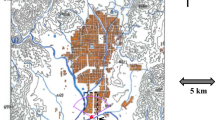Abstract
In order to study the capabilities of a turbulent lidar, an experiment was carried out with a BSE-4 system, a meteorological measuring system, and an MTP-5 temperature profiler. The profile of the structural parameter of the refractive index \(C_{n}^{2}\) was determined with the lidar with a 15-s interval up to an altitude of 2 km. The dynamic turbulence strength was measured over rough terrain when the wind increased. Lidar operation under buoyant convection conditions allowed us to observe the rise of thermals and the formation of Cu clouds in the atmospheric boundary layer. Under the conditions of cellular convection, the lidar recorded quasi-periodic oscillations of \(C_{n}^{2}\) (Benard cells), which represented a stationary wave. Under stable temperature stratification, when the Richardson number was less than 1/4, the turbulent lidar detected a Kelvin–Helmholtz wave.







Similar content being viewed by others
REFERENCES
A. G. Vinogradov, A. S. Gurvich, S. S. Kashkarov, Yu. A. Kravtsov, and V. I. Tatarskii, Invention Certificate No. 359, Byull. Izobret., No. 21 (1989).
A. G. Vinogradov, Yu. A. Kravtsov, and V. I. Tatarskii, “Backscatter enhancement on bodies placed in a randomly inhomogeneous medium,” Izv. Vyssh. Ucheb. Zaved. Radiofiz. 16 (7), 1064–1070 (1973).
Yu. A. Kravtsov and A. I. Saichev, ““Effects of double passage of waves in randomly inhomogeneous media,” Sov. Phys. Usp. 25, 494–508 (1982)
A. S. Gurvich, “Lidar sounding of turbulence based on the backscatter enhancement effect,” Izv. Atmos. Ocean. Phys. 48 (6), 585–594 (2012).
A. S. Gurvich, “Lidar positioning of higher clear-air turbulence regions,” Izv., Atmos. Ocean. Phys. 50 (2), 143–151 (2014).
V. A. Banakh and I. A. Razenkov, “Lidar measurements of atmospheric backscattering amplification,” Opt. Spectrosc. 120 (2), 326–334 (2016).
I. A. Razenkov, “Turbulent lidar: I—Design,” Atmos. Ocean. Opt. 31 (3), 273–280 (2018).
I. A. Razenkov, V. A. Banakh, and E. V. Gordeev, “Lidar “BSE-4” for the atmospheric turbulence measurements,” Proc. SPIE—Int. Soc. Opt. Eng. (2018). https://doi.org/10.1117/12.2505183
I. A. Razenkov, A. I. Nadeev, N. G. Zaitsev, and E. V. Gordeev, “Turbulent UV Lidar BSE-5,” Atmos. Ocean. Opt. 33 (4), 406–414 (2020).
A. S. Gurvich, A. I. Kon, V. L. Mironov, and S. S. Khmelevtsov, Laser Radiation in a Turbulent Atmosphere (Nauka, Moscow, 1976) [in Russian].
I. A. Razenkov, “Experimental estimation of the backscatter enhancement peak,” Atmos. Ocean. Opt. 34 (2), 112–117 (2021).
V. V. Vorob’ev, “On the applicability of asymptotic formulas of retrieving “optical” turbulence parameters from pulse lidar sounding data: I—Equations,” Atmos. Ocean. Opt. 30 (2) 156–161 (2017).
I. A. Razenkov, “Estimation of the turbulence intensity from lidar data,” Atmos. Ocean. Opt. 33 (3), 245–253 (2020).
I. A. Razenkov, “Optimization of parameters of a turbulent lidar,” Atmos. Ocean. Opt. 32 (3), 349–360 (2019).
I. A. Razenkov, “Specifics of sounding the atmospheric boundary layer with a turbulent lidar,” Atmos. Ocean. Opt. 33 (6), 610–615 (2020).
I. A. Razenkov, “Turbulent lidar: II—Experiment,” Atmos. Ocean. Opt. 31 (3) 281–289 (2018).
G. G. Shuster, Deterministic Chaos. Introduction (Mir, Moscow, 1988) [in Russian].
V. V. Nosov, V. P. Lukin, P. G. Kovadlo, E. V. Nosov, and A. V. Torgaev, Optical Properties of a Turbulence in High-Mountain Atmospheric Boundary Layer (Publishing House of Siberian Branch, Russian Academy of Sciences, Novosibirsk, 2016) [in Russian].
V. V. Nosov, “Atmospheric turbulence in the anisotropic boundary layer, in Optical Waves and Laser Beams in the Irregular Atmosphere (Taylor & Francis Group, CRC Press, Boca Raton, London; New York, 2018).
G. G. Gimmestad, D. W. Roberts, J. M. Stewart, and J. W. Wood, “Development of the lidar technique for the profiling optical turbulence,” Opt. Eng. 51 (10) (2012). https://doi.org/10.1117/1.OE.51.10.101713
https://lop.iao.ru/. Cited September 20, 2020.
http://attex.net/RU/mtp5.php. Cited September 20, 2020.
S. M. Shmeter, Physics of Convective Clouds (Gidrometeoizdat, Leningrad, 1972) [in Russian].
N. P. Shakina, Hydrodynamic Instability in the Atmosphere (Gidrometeoizdat, Leningrad, 1990) [in Russian].
E. Gossard and W. Hooke, Waves in the Atmosphere (Elsevier, 1975).
J. W. Miles, “On the stability of heterogeneous shear flow,” J. Fluid Mech. 10 (4), 496–509 (1961).
S. L. Odintsov, “Peculiarities in motion of the lower atmospheric layer at passage of the internal gravity waves,” Atmos. Ocean. Opt. 15 (12), 1026–1030 (2002).
Dynamics of Wave and Exchange Processes in the Atmosphere, Ed. by O.G. Chkhetiani, M.E. Gorbunova, S.N. Kulichkova, and I.A. Repina, “(GEOS, Moscow, 2017) [in Russian].
N. P. Shakina and A. R. Ivanova, Forecast of Meteorological Conditions for Aircraft (TRIADA, Moscow, 2016) [in Russian].
ACKNOWLEDGMENTS
The author is grateful to V.V. Nosov for the useful discussion of the issues of the turbulence structure and Yu.S. Balin for constructive remarks; to the atmospheric acoustics group for the MTP-5 temperature profiler data, and the laboratory of atmospheric composition climatology for prompt provision of meteorological information from the measuring complex of IAO SB RAS.
Funding
The work was supported by the Ministry of Science and Higher Education of the Russian Federation (V.E. Zuev Institute of Atmospheric Optics of Siberian Branch of the Russian Academy of Sciences).
Author information
Authors and Affiliations
Corresponding author
Ethics declarations
The author declares that he has no conflicts of interest.
Additional information
Translated by O. Ponomareva
Rights and permissions
About this article
Cite this article
Razenkov, I.A. Capabilities of a Turbulent BSE-Lidar for the Study of the Atmospheric Boundary Layer. Atmos Ocean Opt 34, 229–238 (2021). https://doi.org/10.1134/S102485602103012X
Received:
Revised:
Accepted:
Published:
Issue Date:
DOI: https://doi.org/10.1134/S102485602103012X



